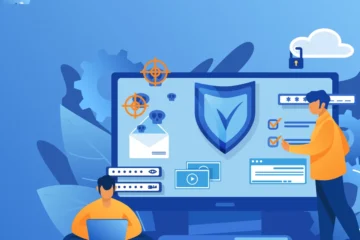Table of Contents
Building a Secure Infrastructure: Cybersecurity for IT Professionals

Cybersecurity has become a critical concern for businesses and organisations of all kinds in today’s linked world.IT professionals play a vital role in building and maintaining a secure infrastructure to safeguard sensitive data, avoid cyber risks, and ensure business continuity. In this blog post, we will explore the importance of cybersecurity for IT professionals and discuss essential strategies and best practices for building a secure infrastructure.
Understanding the Importance of Cybersecurity
Cybersecurity is the practise of preventing unauthorised access, breaches, and hostile attacks on computer systems, networks, and data. It is crucial for IT professionals to prioritize cybersecurity to safeguard sensitive information, maintain the integrity of systems, and protect against financial losses and reputational damage.
Implementing a Layered Defense Strategy
A layered defense strategy involves implementing multiple layers of security controls to protect against various types of cyber threats. IT professionals should focus on the following key areas:
Network Security: Implement firewalls, intrusion detection and prevention systems, and secure network architecture to protect against unauthorized access and network-based attacks.
Endpoint Security: Employ robust antivirus and anti-malware solutions, endpoint encryption, and regular patch management to secure devices and prevent malware infections.
Data Protection: Utilize strong encryption methods to protect sensitive data at rest and in transit. Implement access controls, data backup and recovery plans, and regular vulnerability assessments to ensure data integrity and availability.
Identity and Access Management: Implement strong authentication mechanisms, such as multi-factor authentication, and enforce proper user access controls to prevent unauthorized access to systems and data.
Security Awareness and Training: Promote a culture of security awareness among employees through regular training programs. Educate users about common security threats, social engineering techniques, and best practices for safe computing.
Regular Vulnerability Assessments and Penetration Testing
Perform regular vulnerability assessments and penetration testing to identify and address potential weaknesses in the infrastructure. This involves systematically evaluating system components, applications, and network configurations to identify vulnerabilities and assess their potential impact. By identifying and remediating vulnerabilities proactively, IT professionals can minimize the risk of successful attacks.
Incident Response Planning
Develop and implement an incident response plan to effectively respond to security incidents and minimize their impact. Define roles and responsibilities, establish communication channels, and conduct regular tabletop exercises to test the effectiveness of the plan. A well-prepared incident response plan can help IT professionals respond quickly and effectively to mitigate potential damage.
Continuous Monitoring and Threat Intelligence
Implement continuous monitoring solutions to detect and respond to security incidents in real-time. Utilize security information and event management (SIEM) tools, intrusion detection systems, and log analysis to identify suspicious activities and potential threats. Stay updated with the latest threat intelligence by monitoring industry reports, security forums, and trusted sources to stay one step ahead of emerging threats.
Regular Updates and Patch Management
Stay vigilant with software updates and patch management to ensure that systems are protected against known vulnerabilities. Implement a structured patch management process that includes regular patch assessments, testing, and deployment to minimize the risk of exploitation.
Security Governance and Compliance
Establish a security governance framework that aligns with industry best practices and regulatory requirements. Adhere to relevant compliance standards, such as the General Data Protection Regulation (GDPR) or the Payment Card Industry Data Security Standard (PCI DSS). Regularly audit and assess security controls to ensure ongoing compliance.
Conclusion
Building a secure infrastructure is paramount for IT professionals to protect sensitive data, prevent cyber threats, and maintain business continuity. By implementing a layered defense strategy, conducting regular vulnerability assessments, having an incident response plan in place, utilizing continuous monitoring and threat intelligence, prioritizing patch management, and adhering to security governance and compliance standards, IT professionals can create a robust and resilient cybersecurity posture. By staying proactive and vigilant, IT professionals can effectively safeguard organizations against ever-evolving cyber threats and ensure the confidentiality, integrity, and availability of critical systems and data.



